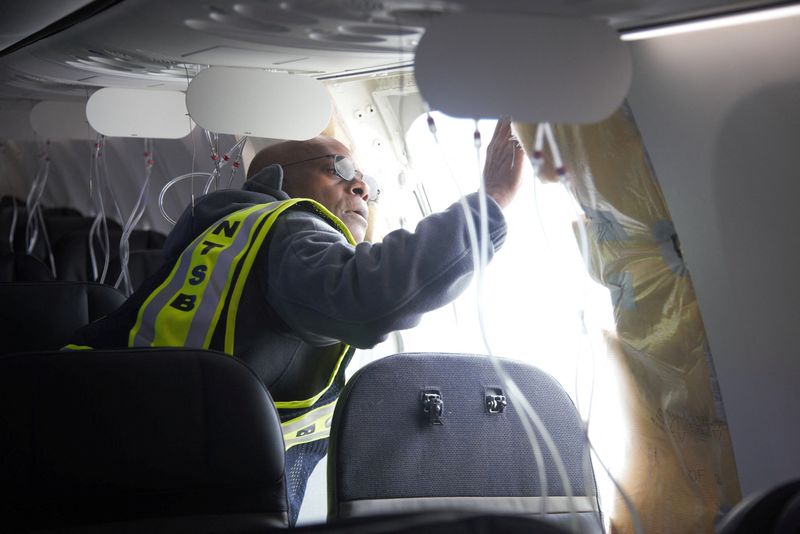(Reuters) – A serious mid-air breach has landed planemaker Boeing in the regulatory crosshairs just as it was awaiting approval of new models of its best-selling MAX jet.
Investigators are still trying to determine what caused a door plug to fall off from the side of a 737 MAX 9 aircraft operated by Alaska Airlines on Friday, with 171 passengers on board.
This is what aerospace analysts are saying about the expected impact of the incident on Boeing:
CAI VON RUMOHR, TD COWEN ANALYST:
“The check required by the FAA (Federal Aviation Administration) is expected to take 4-8 hours, which is far less than was the case with the recent issue with 737 aft pressure bulkhead, which is far more difficult to access.
“As a result, we think the checks will most likely be completed in several days; and once the NTSB (National Transportation Safety Board) determines the root cause of the Alaska Air incident, we think a fix should not be complicated and may be as straightforward as requiring more rigorous and extensive inspection of the exit door plugs at Spirit and Boeing.
“The question then is whether the FAA will require more frequent inspection of MAX 9 exit door plugs and whether it will require more extensive pre-delivery inspection of MAX 9’s at Boeing that would impact the pace of deliveries. Based on the FAA’s response to the 737’s aft pressure bulkhead and vertical stabilizer issue, which could have had equally serious consequences if not addressed, we think this is unlikely.”
NICOLAS OWENS, MORNINGSTAR ANALYST:
“At this point, we do not believe those inspections or any revision to how the 737 MAX-9 fuselages are made by Spirit Aero Systems as a supplier to Boeing will have a material financial impact on Boeing or its customers, and our $232 fair value estimate is unchanged. However, the dramatic nature of the flaw will have the effect of once again calling Boeing’s product governance into question by customers, regulators, and the flying public.”
JPMORGAN ANALYSTS:
“Perhaps the most consequential foreign regulator now is China, where the government has not yet allowed carriers to resume 737 MAX deliveries, though China’s entire fleet of nearly 100 MAXs was flying by the end of last year. Boeing has seemed on the cusp on resuming deliveries to China for some time, with positive signals in recent months. Friday’s accident could delay this process, though Chinese carriers do not fly MAX 9s and we are not aware they have ordered any.”
JEFFERIES ANALYSTS:
“We currently see a low cost of compliance given the Federal Aviation Administration (FAA) has guided to a 4-8hr inspection per jet. In past, ADs (Airworthiness Directives) the FAA has used $85/hr as a cost est. for labor. Assuming inspection costs of $10K per unit (likely too high, but includes potential content costs), the cost would be $1.7MM across the 171 aircraft w/ BA/suppliers shouldering given typical 4-year warranty. Concession would not be contractual, but if we assume a baseline pause of 1 week, concessions could be 7 x $15K per day x 171 aircraft = $18MM.”
(Compiled by Anne Marie Roantree; Editing by Jamie Freed)








